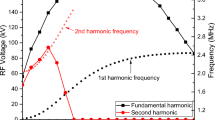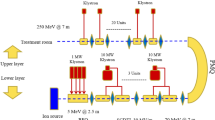Abstract
Purpose
Recent researches of RF gun operated at cryogenic temperature have many advantages to serve as the technology to realize the future light source. In order to further improve the accelerating gradient of accelerators, the cryogenic acceleration structure is studied.
Design/methodology/approach
The cryogenic accelerating structure is studied by numerical analysis and simulation.
Findings
In this paper, the low-temperature characteristics of the material are analyzed firstly, and then the preliminary design scheme of the cavity is proposed according to the analysis results. Furthermore, the prototype with RF coupler is designed and optimized systemically, and the modified Poynting vector distribution is calculated. Finally, the high-power test based on existed setup is also proposed.
Originality/value
The study of the cryogenic structure in this paper is helpful for improving the accelerating gradient and developing compact accelerators.












Similar content being viewed by others
References
A.J. Saversky, I.S. Shchedrin. Measurement of microwave properties of x-band accelerating structure under pulsed high-power operation at liquid-nitrogen temperature. In: 1993 Particle Accelerator Conference. (IEEE, Washington, Dc, 1993)
V. Vogel, K. Floettmann, S. Schreiber, Cold photocathode RF gun, in Proc. IPAC'11 (San Sebastian, Spain, 2011), paper MOPC007, pp. 77–79
T. Sakai et al., RF Characteristics of 20K cryogenic 2.6-cell photocathode RF-gun test cavity, in Proc. LINAC'14 (Geneva, Switzerland, 2014), paper TUPP106, pp. 671–673
C. Wang, J.H. Tan, X.X. Huang, Y.X. Lu, Z.T. Zhao, Design optimization and cold RF test of a 2.6-cell cryogenic RF gun. Nucl. Sci. Tech. 32(9), 10 (2021)
C. Wang, J.H. Tan, Z.H. Zhu, X.X. Huang, L. Wang, W.C. Fang et al., Design and low-power RF test of a C-band cryogenic RF gun. Nucl. Instrum. Methods Phys. Res. Sect. A: Accel. Spectrom. Detect. Assoc. Equip. 1010, 165488 (2021)
G. Reuter, E.H. Sondheimer, The theory of the anomalous skin effect in metals. Nature 161(1042), 336–364 (1948)
R.G.Chambers, The anomalous skin effect. In: Proceedings of the Royal Society of London. Series A. Mathematical and Physical Sciences. (1952)
G.R. Henry, Anomalous skin effect in thin-films. J. Appl. Phys. 43(7), 2996–3000 (1972)
B.J. Munroe et al., High power breakdown testing of a photonic band-gap accelerator structure with elliptical rods. Phys. Rev. Spec. Top. Accel. Beams 16(1), 13 (2013)
M. Othman et al., High Gradient and rf breakdown measurements in a millimeter-wave accelerating cavity. In: 2020 45th International Conference on Infrared, Millimeter and Terahertz Waves (IRMMW-THz). (2020).
A.D. Cahill et al., High gradient experiments with X-band cryogenic copper accelerating cavities. Phys. Rev. Accel. Beams 21(10), 11 (2018)
A. Grudiev, S. Calatroni, W. Wuensch, New local field quantity describing the high gradient limit of accelerating structures (vol 12, 102001, 2009). Phys. Rev. Spec. Top. Accel. Beams 14(9), 1 (2011)
A.D. Cahill, A. Fukasawa, J.B. Rosenzweig, Measurements of copper RF surface resistance at cryogenic temperatures for applications to X-band and S-band accelerators. (2016)
L.A. Hall, Survey of electrical resistivity measurements on 16 pure metals in the temperature range 0 to 273 deg K (National Bureau of Standards, Boulder, CO, 1968)
N.J. Simon, E.S. Drexler, R.P. Reed, Properties of Copper and Copper Alloys at Cryogenic Temperatures (1992)
H.M. Ledbetter, E.R. Naimon, Elastic properties of metals and alloys. II. Copper. J. Phys. Chem. Ref. Data 3(4), 897–935 (1974)
Author information
Authors and Affiliations
Corresponding authors
Rights and permissions
Springer Nature or its licensor holds exclusive rights to this article under a publishing agreement with the author(s) or other rightsholder(s); author self-archiving of the accepted manuscript version of this article is solely governed by the terms of such publishing agreement and applicable law.
About this article
Cite this article
Gao, ZH., Wang, C., Fang, WC. et al. Study and design of cryogenic accelerating structure and RF optimization of single cell for SXFEL energy upgrading. Radiat Detect Technol Methods 6, 367–374 (2022). https://doi.org/10.1007/s41605-022-00341-5
Received:
Revised:
Accepted:
Published:
Issue Date:
DOI: https://doi.org/10.1007/s41605-022-00341-5




